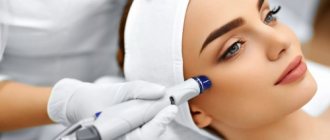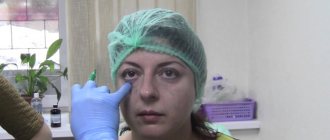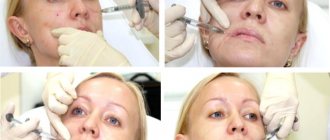Complications and side effects after injection of fillers
Contour plastic surgery with fillers based on hyaluronic acid is considered one of the safest aesthetic procedures. However, complications are still possible. What are these complications and can they be managed?
Contouring specialists are often compared to sculptors. Smooth out wrinkles, give youthful roundness to the cheekbones and cheeks, straighten the oval of the face, add volume to the lips - fillers based on hyaluronic acid can do all this.
Side effect or complication after fillers?
When injecting fillers, two groups of problems are possible: unwanted side effects and complications.
Unwanted side effects after fillers
These include conditions that do not directly threaten the patient's health. These problems include:
- Hematomas. Small bruises in the injection area occur due to damage to small vessels by the needle.
- Swelling after injections. It is a natural inflammatory reaction of tissues to any injury. Remember how the bruised area swells.
- Impaired sensitivity. Appears due to temporary “compression” of the nerves by the filler.
- The appearance of pigmentation at the sites of filler injection. In response to injury to skin cells, melanocytes sometimes begin to produce the pigment melanin.
- Tyndall effect. Due to prolonged tissue swelling after trauma, the functioning of skin vessels is disrupted. As a result, when light is refracted, bluish or pinkish stripes “shine through” under the skin, and sometimes nearby vessels become noticeable. Most often, this side effect after injection of fillers occurs when too dense a product is injected close enough to the surface of the skin.
Complications after fillers
Complications can also often be predicted. But. Unlike side effects, their consequences are unfavorable, affecting the health and aesthetic result of the procedure. Complications are always associated with the prescription of some type of treatment, that is, they require direct medical intervention.
- Tissue necrosis. This is the most serious complication after fillers, occurring due to the gel getting into the vessel or compression (squeezing) of the vessel.
- Long-term loss of sensation at the injection site. Like short-term, it is a consequence of “squeezing” the nerves with filler.
- Contouring (blooming) of the drug under the skin
- It occurs when filler is injected too close to the surface of the skin.
- Whitening of the skin at injection sites. This complication after fillers occurs for a number of reasons. Instant whitening without pain can be caused by the presence of the anesthetic lidocaine in the drug. Whitening, accompanied by sharp pain-embolism (“blockage”) of the vessel when the drug enters it. Sometimes this condition is caused by ischemia (impaired blood supply) of the capillaries of the dermis - this condition usually goes away on its own over time. - Fibrosis. Thickening of the skin at the injection site, manifested in the production of new collagen fibers and the proliferation of connective tissue, is a natural tissue reaction to any foreign substance. Thus, the body tries to fence itself off from it. But sometimes this growth is excessive - skin thickening becomes too noticeable.
- Granulomas are tiny nodules that appear on the surface of the skin. Such complications after fillers appear as a result of the body’s desire to fence off the foreign substance. The foreign body is contained in a kind of capsule. Granulomas can be either inflammatory or non-inflammatory.
- Changes in skin texture in the area of filler injection. Occurs due to filler migration, uneven distribution, or injection too close to the skin surface.
Depending on the time of occurrence, side effects and complications can be early or delayed.
Early adverse events, such as bruising or whitening of the skin, occur immediately after filler injection.
Delayed ones - infection of the injection area, hyperpigmentation at the site of the hematoma, etc. - appear after a few days or later.
What measures can the patient take to avoid these complications?
- Carry out the procedure only in a specialized clinic/clinic where all rules of asepsis and antisepsis are observed and the necessary emergency equipment is available.
- Inquire in advance about the doctor’s qualifications. Unfortunately, in the practice of a cosmetologist, adverse events are not so rare. And the more often, the longer the cosmetologist’s work experience. This depends not only on the experience of the doctor, but also on the number of different patients. However, when communicating with an experienced specialist, this risk is certainly less. Besides, he knows how to deal with them.
- Pay attention to how carefully the doctor collects anamnesis during the consultation - he is interested in previous and existing diseases, medications taken, as well as injections that were done before. Such a conversation allows you to avoid complications and side effects after the injection of fillers. Various autoimmune diseases can cause granulomas, and taking certain medications can lead to immunosuppression. Do not hide information about your health status; this can be extremely important for the successful outcome of the procedure.
- When performing contour plastic surgery, the doctor must use only certified drugs. This information must be available in the clinic. Before the procedure, their name and number must be entered into the medical record.
- Strictly and carefully follow the doctor’s recommendations before and after the procedure (do not go to the sauna, do not sunbathe, do not massage the injection sites, etc.). If complications occur, you should immediately consult a doctor.
Chistyakova O.A.
Immediately or after?
Side effects and complications after fillers are also divided by time of occurrence and severity.
Depending on the time of occurrence, side effects and complications can be early or delayed.
Early adverse events, such as bruising or whitening of the skin, occur immediately after filler injection. Delayed - infection of the injection area, hyperpigmentation at the site of the hematoma, etc. - appear after a few days or later. Late-term complications after fillers also include “remote hypersensitivity reaction.” It is the result of an immune conflict - the immune system spends a long time trying to “come to terms” with a substance introduced from outside and still recognizes it as foreign. This extremely rare complication most often occurs with the administration of biodegradable drugs.
By severity, adverse events can be divided into mild, moderate and severe.
If unwanted side effects after fillers (the same hematomas) most often go away on their own, the doctor should respond to complications immediately. If you suspect the development of necrosis, the cause of which is compression of a vessel or nerve, the doctor first needs to leave the surgical field and immediately stop administering the drug. And then carry out certain manipulations. For example, a hard massage of this area using a drug with an anti-inflammatory and stimulating blood circulation effect. And then - cold lotions to avoid further compression of the blood vessels. If extensive hematomas and swelling occur, systemic anti-inflammatory and decongestant drugs may be prescribed.
Consequences and measures to prevent the situation from getting worse
The appearance of fibrous nodes after the filler injection procedure is not a fatal condition. Fibrosis is usually perceived as a kind of cosmetic defect of the skin. However, mechanical damage to such a seal may result in complications:
- minor bleeding;
- wound infection;
- pain syndrome;
- necrosis of injured tissues.
The last of the listed complications - tissue necrosis - is worth considering in more detail, due to the fact that it is the most undesirable, unpleasant of all possible consequences of the injection of fillers. In addition, the result of such a complication can even be fatal.
Formation of fibrosis after threads
After thread lifting, scar tissue forms in the tissues - this is a normal process, as a result of which collagen is released and a supporting frame is formed. But sometimes, instead of the planned result, collagen can grow around the thread in separate fibers, which leads to solid fibrous cords. This appears at 3-4 weeks. Once they are detected, it is necessary to begin immediate treatment, which will be selected by your doctor.
“Threads promote fibrosis!” Is this so?Clinic of Plastic Surgery Grishkyan David RubenovichJune 4
Characteristic signs and symptoms of fibrosis
The introduction of fillers is accompanied by a variety of complications, many of them are very similar to each other: swelling, nodules, bumps, keloids, scars, granulomas. Therefore, it is necessary to be able to distinguish fibrous type capsules from other neoplasms.
Symptoms indicating the development of fibrosis:
- Neoplasms on the face are hard when palpated and can be located in the deep layers of the skin.
- The tumor has clearly defined boundaries, does not move during palpation, its shape is often round, but mushroom-shaped compactions are also found.
- Fibrous capsules contain a large number of blood vessels, which cannot be said about scars.
- Unlike small granulomas, fibrous compactions are larger in size and occupy a very large surface of the skin (from 1 to 7 cm).
- The diagnosis is made based on a visual examination of the affected area, palpation, and ultrasound examination.
Areas of the face most prone to fibrosis
A complication such as tissue fibrosis can occur in any area being corrected: nasolabial folds, lips, area around the mouth, area under the eyes, neck, chest, décolleté. But most often, fibrous type capsules appear when the gel is injected into wrinkles located around the mouth, lower eyelid, upper part of the nasolabial folds, and upper lip.
The formation of fibrosis on the lips is especially often diagnosed . The fact is that the skin in this area is hypersensitive, so swelling can appear even with an injury caused by a needle in the absence of any gel, not to mention the formation of fibrous nodes.
Treatment of fibrosis
In the vast majority of cases, various methods of conservative therapy help to cope with fibrous elements that appear as a result of filler injections. When tissue fibrosis cannot be treated with highly effective drugs, they turn to a surgeon .
Methods of combating neoplasms can be classified as follows:
1. Injection into the center of the tumor of medications aimed at destroying the filler - called hyaluronidase (for example, the drug Diprospan). This manipulation will allow you to remove excess amounts of gel, destroy the filler, or replace it with another drug (if it was introduced too superficially). Also, using hyaluronidase injections, you can remove the agent that compresses the blood vessels. But the introduction of hyaluronidase can provoke a serious problem - tissue necrosis.
2. Injection directly into the area of compaction of a steroid hormonal drug (used when rejection of the gel occurs against the background of the action of the human immune system).
3. Cryodestruction (exposure to cold), cauterization with chemicals or electrocoagulation (exposure to electric current) are effective only against small superficial formations.
4. Surgical excision of nodes. This method is used if fibrous capsules are located in the deep layers of the epidermis or are of impressive size.
5. The latest methods used in the fight against the described problem are laser or radio wave therapy. After 5-7 such procedures, subtle cosmetic defects remain, but the downside is their high cost and absolute ineffectiveness in some cases, while no doctor can confidently guarantee the desired result.
Who is to blame and what to do?
The occurrence of problems after contouring is associated with two main factors. 95% of complications and side effects after fillers are due to errors in injection technique. This could be simple failure to comply with the rules of hygiene, treatment of the surgical field (insufficient cleansing of the skin before the procedure), too deep or superficial injection of filler, or exceeding the recommended volume of filler. And only 5% of complications after fillers are associated with defects in the injected material. With the vast number of fillers on the market, there are not many low-quality materials. These include illegally imported drugs or newly introduced products that have not undergone sufficient clinical trials.
Let's figure out what measures the patient can take to avoid these complications.
- Carry out the procedure only in a specialized clinic, where all septic and antiseptic rules are observed and the necessary emergency equipment is available.
- Take the time to make sure your doctor is qualified. Unfortunately, in the practice of a cosmetologist, adverse events are not so rare. And the more often, the more experience a cosmetologist has. This depends not only on the experience of the doctor, but also on the number of different patients. However, when communicating with an experienced specialist, this risk is certainly less. Besides, he knows how to deal with them.
- Pay attention to how carefully the doctor collects anamnesis during the consultation - he is interested in previous and existing diseases, and medications taken. Such a conversation allows you to avoid complications and side effects after fillers. Various autoimmune diseases can cause granulomas, and taking certain medications can lead to immunosuppression.
- When performing contour plastic surgery, only certified drugs should be used. This information must be available in the clinic. Before the procedure, their name and number must be entered into the medical record.
- Strictly follow your doctor's recommendations before and after the procedure.
Why does swelling appear after lip augmentation?
It’s worth saying right away that swelling after lip augmentation is normal. Swelling is the body’s reaction to tissue injury and drug administration. Even a minimal amount of the highest quality filler and ultra-thin needles do not guarantee the absence of soft tissue swelling.
Hyaluronic acid is a polysaccharide. Its peculiarity is its enormous size molecules. They provide the hydrophilic properties of the substance - the ability to attract and retain water, maintaining a high level of skin hydration and elasticity. At first, until the filler is distributed in the skin and begins to work as usual, the swelling of the lips increases due to the uneven accumulation of fluid.
Edema is always present to one degree or another. Even when it seems to the patient that swelling is the desired result. Swelling on the lips after enlargement may not cause significant discomfort and may not differ much from the subsequent effect. The degree of swelling depends on the reactivity of the body, the quantity and quality of the injected filler. In some cases, swelling can be quite significant and cause quite painful sensations.
Possible causes
Multiple growing fibrous capsules, lumps and other compactions are the most common complications after filler injection. Of course, only a doctor can determine the cause of their appearance, while in some cases the cause of fibrosis is never established and is considered an individual reaction of the body, but some factors can be listed :
- direct transfer of funds or its low quality;
- incorrectly chosen injection technique;
- development of a focus of inflammation;
- mechanical damage to the walls of blood vessels;
- individual reaction of rejection of a foreign substance by the body;
- in the injection area there is a noticeable growth of connective tissue - scars, nodules or cysts (for example, hyaluronic acid enhances the production of fibroblasts);
- failure to comply with hygiene and care rules, and as a result, infection;
- unprofessionalism of the cosmetologist.
In addition, the formation of fibrous capsules can be provoked by an incorrectly calculated dose of the drug, as well as its too superficial administration.
How to minimize the risk of complications?
The first thing you need to do is choose a clinic with a good reputation, a professional cosmetologist, read reviews about his work and study photos of examples of correction. The following recommendations will help you avoid mistakes:
- During the consultation, voice your wishes . The cosmetologist must have a clear idea of what results you want to achieve;
- Let the doctor choose the filler on his own, but ask him to explain to you exactly what is included in it and how it works . At the same time, you must be shown the integrity of the packaging, manufacturer, shelf life and other important information;
- You should definitely discuss options for lip pain relief during injections . Despite the fact that the injections are made with thin needles, the pain will be quite strong. You can make the procedure comfortable by using fillers, which include anesthetics, application or infiltration anesthesia;
- specify in what volumes the cosmetologist plans to inject filler into the lips . Simultaneous injection of a large amount of hyaluronic acid will lead to tissue stretching, which will be very difficult to eliminate.
In some cases, the doctor may refuse to perform the procedure due to detected contraindications. If he considers obvious problems to be unimportant, then perhaps it is worth changing the specialist.
Seals in the lips after correction: normal options
If dense balls appear in some cases, do not panic:
- a dense filler was used : even when the gel is injected to the correct depth and in the required quantity, lumps will be felt inside the lips for some time, and then they will disappear;
- Little time has passed since the procedure : the gels dissolve in the tissues quite slowly. You can speed up this process with the help of a special massage. But it is strictly forbidden to knead the seals yourself - this must be done by the doctor who performed the injections.
To determine whether you should worry, you need to answer a number of questions:
- Are gel accumulations visible under the skin?
- Is there deformation of certain areas of the lips due to displacement of the gel?
- Is there lip asymmetry that was not there before?
- When examined, are there white balls on the mucous membranes after a few days?
If the answer is positive to at least one of the questions, then you need to schedule a visit to a cosmetologist in the near future. The decision to prescribe any procedures is made only by a specialist based on examination.










